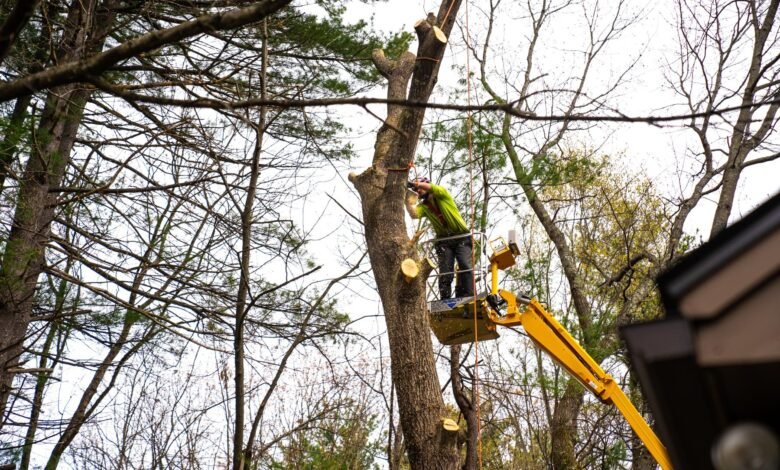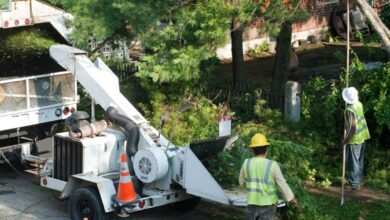The Safe & Smart Tree Removal Process: From Assessment to Aftercare

Introduction
Removing a tree from a yard, street, or commercial property is more than just cutting wood it’s a coordinated process that blends safety, environmental judgment, local rules, and skilled execution. Whether a tree is diseased, structurally unsound, in the way of construction, or poses an immediate hazard after a storm, proper removal protects people and property and preserves the surrounding landscape. This guide walks you through the full tree removal process from first assessment through post-removal care and common questions homeowners ask. It emphasizes evidence-based, professional practices (hire a certified arborist when in doubt), explains why permits and local regulations matter, and outlines the step-by-step actions tree-care teams take to remove a tree safely and efficiently. By following these steps you’ll reduce risk, avoid fines, and ensure the site recovers quickly after removal.
When to Remove a Tree
Deciding whether a tree should be removed requires careful observation and often an expert opinion. Common removal reasons include advanced decay, irreparable structural failure (split trunk or large cracks), root damage that threatens foundations or underground utilities, invasive species that harm the landscape, or trees that obstruct essential sightlines or planned construction. Trees that have been struck by lightning, repeatedly lose large limbs, or show signs of significant crown dieback often present escalating hazards; leaving them can risk sudden collapse. When evaluating a tree, consider both visible conditions and recent changes: leaning that increases over weeks or new soil heave at the base are warning signs. A certified arborist can perform a risk assessment, checking the trunk, root collar, soil, and canopy to estimate failure likelihood. They’ll recommend preservation when possible (pruning, cables, disease treatment) and removal when risk, biology, or practical site needs make removal the safest, most responsible choice.
Assessment, Permits & Planning
Before a chainsaw starts, professionals gather information and secure approvals. Site assessment includes identifying utilities (overhead lines, buried pipes), evaluating access for equipment, and cataloging nearby structures and landscaping that require protection. Many municipalities require permits for tree removal especially for heritage, street, or large mature trees so checking local regulations early avoids fines and project delays. An arborist’s written plan will describe removal methods, required equipment (crane, aerial lift, chipper), crew size, traffic control if near a road, and debris disposal. Risk mitigation is part of planning: isolating the drop zone, scheduling removal during suitable weather, and coordinating with utility companies when lines are involved. Documenting the tree’s condition and the rationale for removal (photos, inspection notes) supports permit applications and demonstrates due diligence. Good planning minimizes surprises, keeps neighbors safe, and often reduces total cost by streamlining the work.
The Tree Removal Steps
A professional removal follows predictable stages to ensure safety and efficiency. First, the crew secures the area, setting up barriers and traffic control if needed. For small-to-medium trees on open lots, arborists may fell the tree in one piece into a cleared drop zone. For larger or riskier trees near homes, powerlines, or fences removal is sectional: a climber or lift operator ascends, cuts the crown into smaller, rigged pieces, and lowers them with ropes or a crane to prevent damage. After trunk sections are brought down, crews process the wood: logs may be cut for firewood, branches run through a chipper into mulch, and smaller debris removed. Stump removal can occur immediately or later and uses grinding machines to reduce the stump below grade and remove roots near structures. Throughout the job, crews continuously reassess hazards, use personal protective equipment, and follow industry safety standards. Clear communication, experienced rigging, and the right equipment are what separate safe professional removals from risky DIY attempts.
Aftercare & Stump Management
Post-removal care helps the site recover and prevents future problems. Stump management options include grinding (the most common), complete stump and root removal (for large construction projects), or leaving the stump to decompose naturally if it doesn’t interfere with use. Grinding removes the visible stump and churns roots into mulch, which can be used on-site; grinding typically leaves the roots to rot over time, so replanting in the exact spot may need additional soil and root removal. If replanting is planned, a soil assessment and amendment improve success. For large root systems near foundations or utilities, targeted root removal may be necessary to avoid future structural damage. Finally, consider erosion control, reseeding or landscaping the cleared area, and monitoring surrounding trees for stresssudden removal can change light and root competition, affecting neighboring specimens. Proper aftercare ensures safety, aesthetic recovery, and long-term landscape health.
Conclusion
The tree removal process is a multi-step, safety-first service that blends technical assessment, legal compliance, careful planning, skilled execution, and thoughtful aftercare. When a tree must come down, relying on trained professionals especially certified arborists reduces risk, protects property, and ensures compliance with local rules. Thoughtful planning and stump management also set the stage for successful replanting or landscaping. If you’re unsure whether to remove a tree or how to proceed, start with an arborist’s risk assessment and check municipal permit requirements; that single step often prevents bigger problems later. Properly done, tree removal preserves safety while respecting the environment and neighborhood character.
Frequently Asked Questions (FAQs)
Q1: How do I know if a tree needs immediate removal?
A1: Immediate removal is usually recommended for trees that have major structural failure (a split trunk, large hanging limb about to fall), active root heave undermining foundations, or obvious interior decay with cavities. After severe storms, have suspect trees inspected right away.
Q2: Will removing a tree damage my lawn and surrounding plants?
A2: Professional crews plan access and protections to minimize impact using matting for heavy equipment, mulching, and hand-removing delicate plants when needed. Some disturbance is possible, but proper aftercare restores lawn and planting beds quickly.
Q3: What’s the difference between stump grinding and stump removal?
A3: Stump grinding reduces the stump below grade and leaves roots to decompose; it’s quicker and cheaper. Stump removal digs out the entire stump and root ball necessary when roots interfere with structures or when replanting at the same spot.
Q4: How much does professional tree removal typically cost?
A4: Cost varies by tree size, location, complexity (near powerlines or structures), and disposal needs. Small, accessible trees cost far less than large, hard-to-access trees that require sectional removal or a crane. Get multiple written estimates that include cleanup and permits.



